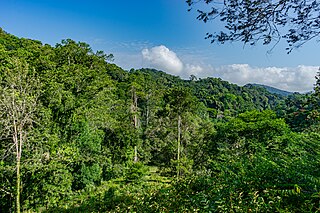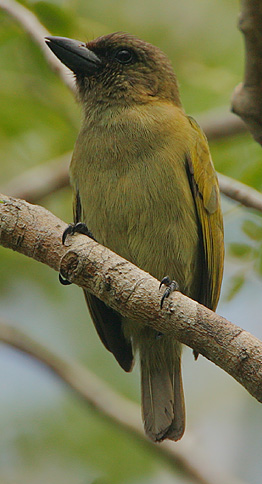
The green-backed camaroptera, also known as the bleating camaroptera, is a small bird in the family Cisticolidae. This bird is a resident breeder in Africa south of the Sahara Desert. Recent studies suggest this species and the grey-backed camaroptera may be the same species.

The Amani Forest Reserve, officially listed as Amani Nature Forest Reserve is a protected area located the Muheza and Korogwe Districts in the Tanga Region of Tanzania. The nature reserve was established in 1997 in order to preserve the unique flora and fauna of the East Usambara Mountains. The East and West Usambara Mountains are a biodiversity hotspot. The Amani Nature Reserve includes tropical cloud forest habitats.

The handsome spurfowl is a species of bird in the pheasant family Phasianidae. It is a large, up to 35 cm long, terrestrial forest bird with a dark reddish brown plumage, grey head, red bill and legs, brown iris, bare red orbital skin and rufous grey below. Both sexes are similar. The female is slightly smaller than male. The young has duller plumage.

The green-winged pytilia is a small colourful seed-eating bird in the family Estrildidae. It is widespread throughout Sub-Saharan Africa, though it is more rarely seen in central, far southern and coastal western parts of the continent.
Winifred's warbler, also known as Mrs. Moreau's warbler, is a species of bird in the family Cisticolidae. The species was first recorded and named by the ornithologist Reginald Moreau after his wife.

The green-capped eremomela or greencap eremomela is a species of bird formerly placed in the "Old World warbler" assemblage, but now placed in the family Cisticolidae.

The banded parisoma, banded tit warbler or banded warbler, is a species of Old World warbler in the family Sylviidae. It is found in Ethiopia, Kenya, Somalia, and Tanzania. Its natural habitat is dry savanna.
The Usambara eagle-owl, also called the East African nduk eagle-owl or Vosseier's eagle-owl, is a taxon of owl in the family Strigidae. It is now regarded as a subspecies of Fraser's eagle-owl. It is endemic to the Usambara Mountains in Tanga Region of Tanzania.
The long-billed forest warbler, also known as the long-billed tailorbird, is a songbird of the family Cisticolidae, formerly part of the "Old World warbler" assemblage. It is found in Tanzania and Mozambique. Its natural habitat is subtropical or tropical moist montane forests. It is threatened by habitat destruction.

The forest batis or short-tailed batis is a species of bird in the wattle-eye family, Platysteiridae occurring in eastern Africa.

The olive-green camaroptera is a bird species in the family Cisticolidae.

The dapple-throat is a species of bird in the small African family Modulatricidae. Other common names include dappled mountain robin and dappled mountain greenbul. It is native to Mozambique and Tanzania. This is the only species in the monotypic genus Arcanator.

The baglafecht weaver is a species of weaver bird from the family Ploceidae which is found in eastern and central Africa. There are several disjunct populations with distinguishable plumage patterns. Only some races display a discrete non-breeding plumage.

Swynnerton's robin is a species of passerine bird belonging to the family Muscicapidae. It is monotypic within the genus Swynnertonia. The common and Latin names commemorate the entomologist Charles Swynnerton.

The green barbet is a species of bird in the Lybiidae family. It is found in Kenya, Tanzania, Malawi, Mozambique and South Africa. It occurs in forests from sea level to 1,800 metres (5,900 ft). Its isolated populations are vulnerable to forest clearing.
The speckle-throated woodpecker, also known as Reichenow's woodpecker, is an East African woodpecker often considered a subspecies of Bennett's woodpecker. The bird is named after the German ornithologist Anton Reichenow.
Artisornis is a genus of birds in the family Cisticolidae. It contains the following species:
The dark batis is a small passerine bird belonging to the genus Batis in the wattle-eye family, Platysteiridae. It is found in highland forest in south-west Tanzania, northern Malawi, and northern Mozambique. These birds were formerly thought to be forest batises but in 2006 were described as a new species based on differences in morphology and mitochondrial DNA from those birds in northern Tanzania and Kenya.

The cinnamon-breasted tit is passerine bird in the family Paridae. It is found in Tanzania, Malawi, Mozambique and Zimbabwe. Its natural habitat is miombo woodland.

The olive-headed greenbul is a species of the bulbul family of passerine birds. It is found in east Africa.














